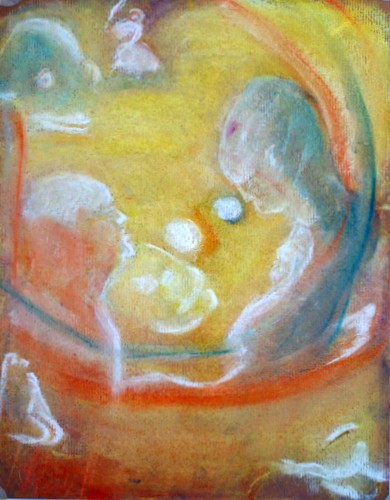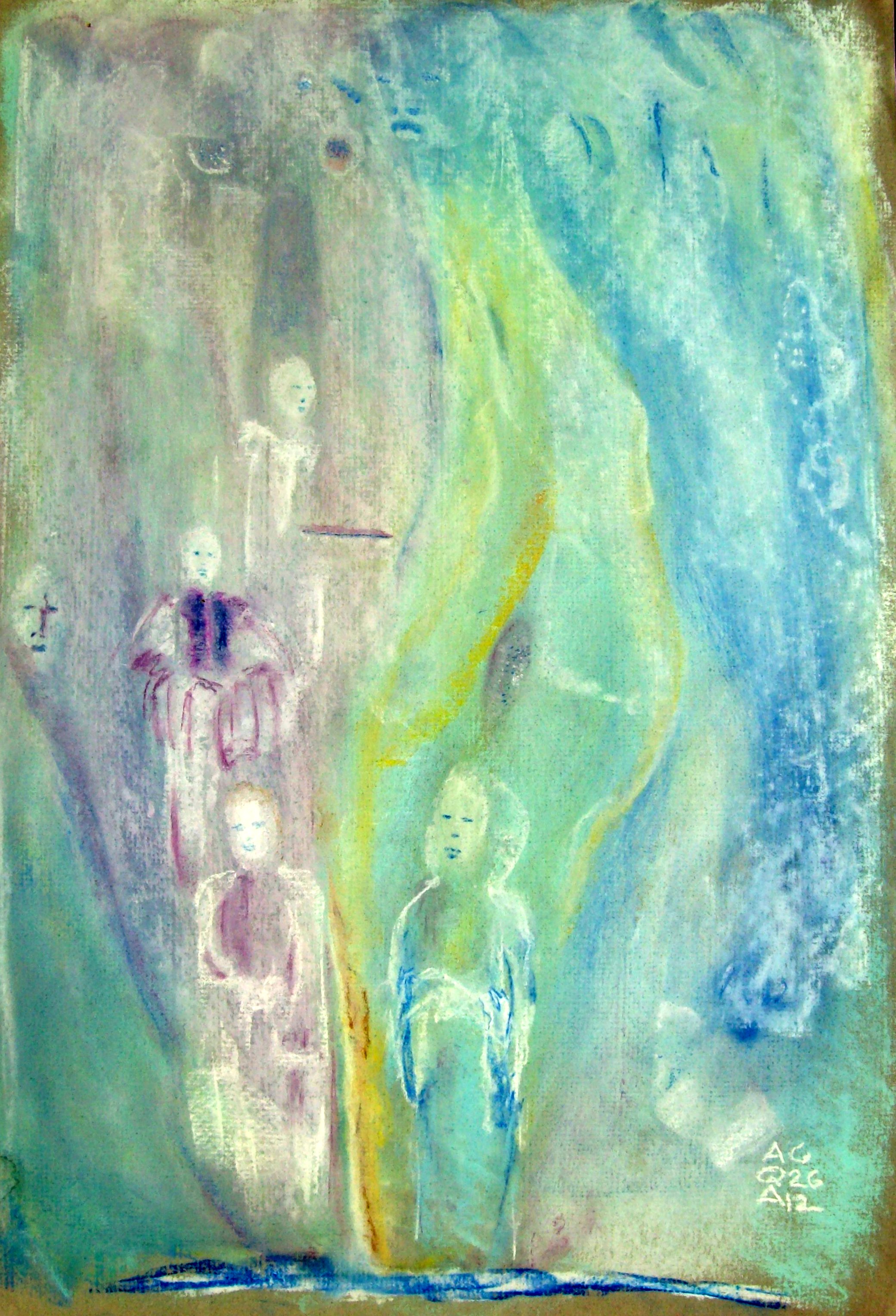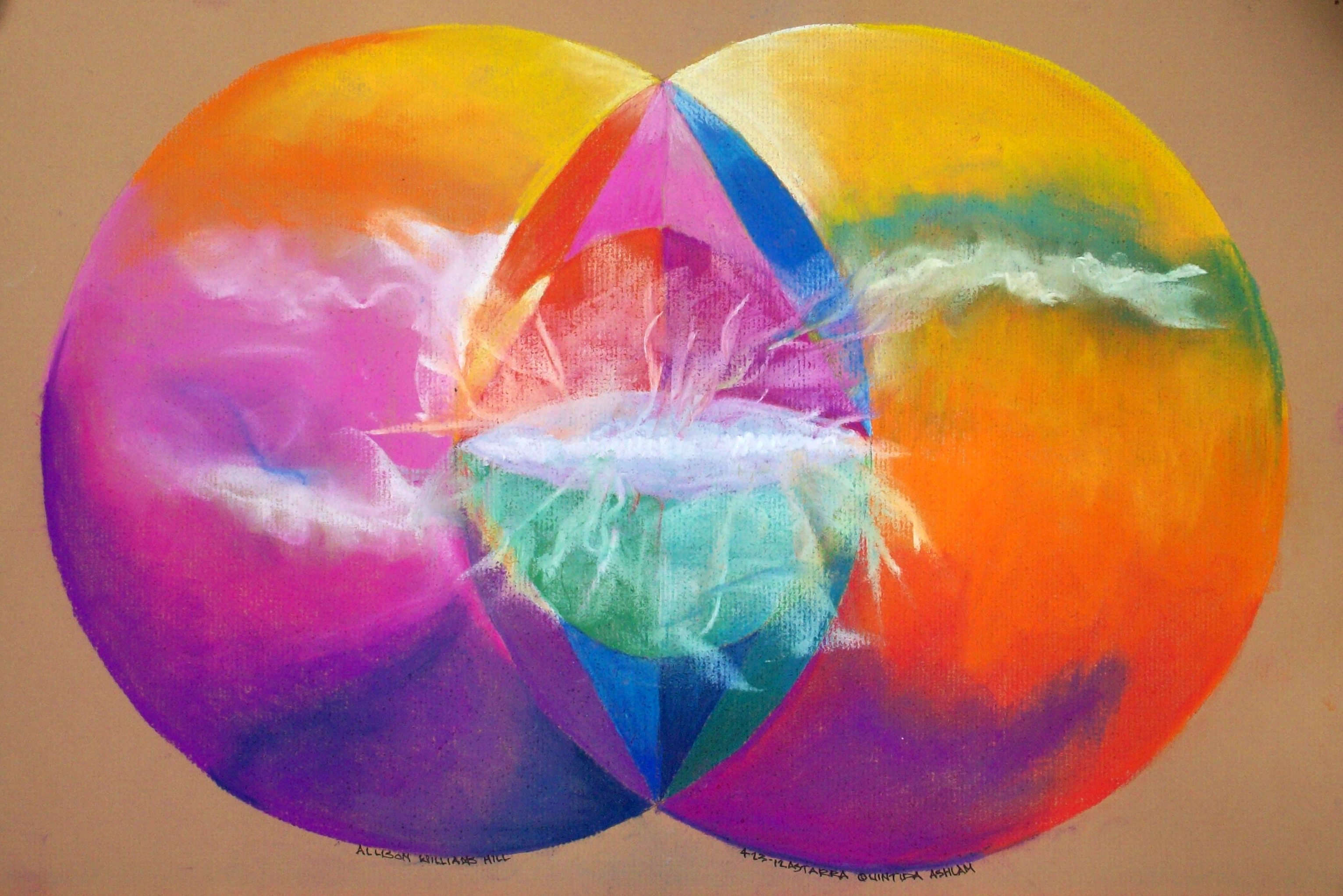Microscopic Level
from "100 Interesting Facts About the Human Body"
Much of what takes place in our bodies happens at a level that we simply can’t see with the naked eye. These facts will show you that sometimes that might be for the best.

Ascension by Allison L. Williams Hill
81. About 32 million bacteria call every inch of your skin home. Germaphobes don’t need to worry however, as a majority of these are entirely harmless and some are even helpful in maintaining a healthy body.
82. Humans shed and regrow outer skin cells about every 27 days. Skin protects your delicate internal organs from the elements and as such, dries and flakes off completely about once a month so that it can maintain its strength. Chances are that last month’s skin is still hanging around your house in the form of the dust on your bookshelf or under the couch.
83. Three hundred million cells die in the human body every minute. While that sounds like a lot, it’s really just a small fraction of the cells that are in the human body. Estimates have placed the total number of cells in the body at 1050 trillion so you can afford to lose a few hundred million without a hitch.
84. Humans shed about 600,000 particles of skin every hour. You may not think much about losing skin if yours isn’t dry or flaky or peeling from a sunburn, but your skin is constantly renewing itself and shedding dead cells.
"Every day an adult body produces 300 billion new cells."
FANTASTIC OPPORTUNITIES FOR CHANGE!
85. Every day an adult body produces 300 billion new cells. Your body not only needs energy to keep your organs up and running but also to constantly repair and build new cells to form the building blocks of your body itself.
86. Every tongue print is unique. If you’re planning on committing a crime, don’t think you’ll get away with leaving a tongue print behind. Each tongue is different and yours could be unique enough to finger you as the culprit.

"Merge with Krishna" by Allison L. Williams Hill
87. Your body has enough iron in it to make a nail 3 inches long. Anyone who has ever tasted blood knows that it has a slightly metallic taste. This is due to the high levels of iron in the blood. If you were to take all of this iron out of the body, you’d have enough to make a small nail and very severe anemia.
88. The most common blood type in the world is Type O. Blood banks find it valuable as it can be given to those with both type A and B blood. The rarest blood type, AH or Bombay blood due to the location of its discovery, has been found in less than hundred people since it was discovered.
89. Human lips have a reddish color because of the great concentration of tiny
capillaries just below the skin. The blood in these capillaries is normally highly
oxygenated and therefore quite red. This explains why the lips appear pale when a person is anemic or has lost a great deal of blood. It also explains why the lips turn blue in very cold weather. Cold causes the capillaries to constrict, and the blood loses oxygen and changes to a darker color.
A few things you might not have known about all different parts of your anatomy
90. The colder the room you sleep in, the better the chances are that you’ll have a bad dream. It isn’t entirely clear to scientists why this is the case, but if you are opposed to having nightmares you might want to keep yourself a little toastier at night.
91. Tears and mucus contain an enzyme (lysozyme) that breaks down the cell wall of many bacteria. This is to your advantage, as the mucus that lines your nose and throat, as well as the tears that wet your eyes are helping to prevent bacteria from infecting those areas and making you sick.
92. Your body gives off enough heat in 30 minutes to bring half a gallon of water to a boil. If you’ve seen the Matrix you are aware of the energy potentially generated by the human body. Our bodies expend a large amount of calories keeping us at a steady 98.6 degrees, enough to boil water or even cook pasta.
93.
Your ears secrete more earwax when you are afraid than when you aren’t.
The chemicals and hormones released when you are afraid could be having
unseen effects on your body in the form of earwax. Studies have
suggested that fear causes the ears to produce more of the sticky
substance, though the reasons are not yet clear.
94.
It is not possible to tickle yourself. Even the most ticklish among us
do not have the ability to tickle ourselves. The reason behind this is
that your brain predicts the tickle from information it already has,
like how your fingers are moving. Because it knows and can feel where
the tickle is coming from, your brain doesn’t respond in the same way as
it would if someone else was doing the tickling.

"In the animal world, humans are the biggest crybabies..."
95. The width of your arm-span stretched out is the length of your whole body. While not exact down to the last millimeter, your arm-span is a pretty good estimator of your height.
96. Humans are the only animals to produce emotional tears. In the animal world, humans are the biggest crybabies, being the only animals who cry because they’ve had a bad day, lost a loved one, or just don’t feel good.
97. Right-handed people live, on average, nine years longer than lefthanded
people do. This doesn’t have a genetic basis, but is largely due to the fact that a majority of the machines and tools we use on a daily basis are designed for those who are right handed, making them somewhat dangerous for lefties to use and resulting in thousands of accidents and deaths each year.
98. Women burn fat more slowly than men, by a rate of about 50 calories a day. Most men have a much easier time burning fat than women. Women, because of their reproductive role, generally require a higher basic body fat proportion than men, and as a result their bodies don’t get rid of excess fat at the same rate as men.
99.
Koalas and primates are the only animals with unique fingerprints.
Humans, apes and koalas are unique in the animal kingdom due to the
tiny prints on the fingers of their hands. Studies on primates have
suggested that even cloned individuals have unique fingerprints.
100.
The indentation in the middle of the area between the nose and the
upper lip has a name. It is called the philtrum. Scientists have yet to
figure out what purpose this indentation serves, though the ancient
Greeks thought it to be one of the most erogenous places on the body.
Links

The above meditation mandala will be available soon.



